- You are here:
- Home »
- Top Story »
- You’re the Head of Government? Need to run the country? There’s an app for that!
You’re the Head of Government? Need to run the country? There’s an app for that!
3 December 2012– There was a great piece in The New York Times a few days ago (for the story click here) about David Cameron (Britain’s prime minister) and his passion for his iPad, one of his senior advisers saying he spends “a crazy, scary amount of time playing Fruit Ninja”.
Well, it is a bit more than that. Such is Cameron’s devotion that he ordered the creation of an iPad app that would allow him to monitor the British economy. Called the “No. 10 Dashboard” (available for 99 cents on iTunes, by the way) it gives the prime minister and senior Whitehall officials an “at-a-glance overview of everything that’s happening in government and elsewhere — stock prices, housing and jobs data, information on the performance of government departments, as well as the political context: polls, commentary and indications of the national mood from sources like Twitter. The prime minister liked having quotable facts about what was going on”.
The No. 10 Dashboard could be the White House Dashboard; Mr. Cameron plans to show the app to President Obama at the Group of 8 summit meeting.
Yes, a manifestation of cybernetics: the study of control and communication in large, complex systems, be they organisms, machines or organizations.
And there is a mention of Eden Medina’s new book “Cybernetic Revolutioanries” which discusses how Chile envisoned a similar system back in the 1970s – a system wherein Salvador Allende’s ministers would have made informed decisions “in chairs with control panels built into the armrests. Photos of this room still retain a veneer of giddy futurity. White surfaces, pared-down interfaces, rounded corners — a dash of Apple in the mix”. Eden is a fellow member of SIGCIS, the Special Interest Group Computers, Information and Society. SIGCIS is the leading international group for historians with an interest in the history of information technology and its applications. We just had our 2012 workshop in Copenhagen, Denmark.
Ah, data. Ah, technology. The proliferation of technology has dramatically infiltrated all aspects of modern life. In many ways the world is becoming so dynamic and complex that technological capabilities are overwhelming human capabilities to optimally interact with and leverage those technologies. The zombie apocalypse of devices is upon us. And you need an app for EVERYTHING just to survive.
Or maybe not.
A few weeks ago I had the pleasure of seeing a preview of the new James Bond filmSkyfall, courtesy of EMC Corporation (some of their technology was used in the making of the movie). My favorite line was by the new “Q”: “I’m your new quartermaster. I’ll hazard I can do more damage on my laptop, sitting in my pajamas, than you can do in a year in the field.”
I had a chance to chat with some of the technology geeks in attendance and we discussed how the ubiquity of devices and applications has created a wholly different landscape from desktop computing, just as the desktop diverged from the mainframe. But the problem with mobile apps is that they are a holdover form of the desktop paradigm. Designers and developers need to embrace a new paradigm … and that is the evolving technology of not apps as we know them but by using a devise to automatically load applications opportunistically as we need them, in real time. An example given … very appropriate considering the venue … was a movie poster. You stop in front of a movie poster with a trailer app. Are you really going to find and download its app before watching the trailer? No. You want just-in-time interaction. And the technology is already here. Your device will broadcast its “name” wirelessly and be discovered by all nearby smart displays. You will watch the trailer effortlessly. If you have been to Madrid you know about Samsung’s “TecTiles” across certain squares and streets. These are enabled cloud-based pop-up apps embedded in specially market tiles that offer localized information and services on your mobile device as you step on the tile.
The problem that nearly every smart product today has a mobile app for your phone (usually iPhone or Android, but rarely works on both). This works for today’s market but will eventually break down. As smart devices become more plentiful, will we be responsible for installing, organizing and launching every app we need for every device in our lives? No.
If you have attended any of the disruptive technology conferences you have seen use of many of these technologies already in “system on a chip” devices and the scores of smart products today with web-connected thermostats, W-Fi bathroom scales, prescription medicine bottles that “call out” when you forgot to take your pill, or need more, etc., etc.
Yes, the “internet of things”. Because the technological model for this, simply enough, is web pages. But these will be web pages with advanced functionality that can be accessed seamlessly from remote or local networks. And even from other mobile devices.
This whole concept of “just-in-time interaction” and the technology behind is the lead subject of this year’s Le Web which I attend every year. I’ll have a full report in January.
Founder/CEO, The Posse List

